Billy Jones Wildcat Railroad and W.E. “Bill” Mason Carousel
William “Billy” Jones – Born 1884, Died 1968
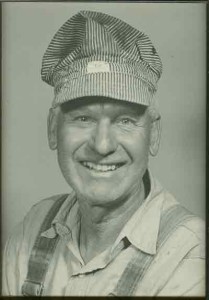
Photo courtesy of Jones’ Family Collection.
Billy Jones was a railroad man for nearly his entire life. He was born in 1884 in Ben Lomond, California and at age 13, he began his railroad employment as a roustabout with the South Pacific Coast Railroad. He would eventually work for the Southern Pacific Railroad running locomotives up and down the California coast until his retirement in 1950.
In 1939, Billy was on a layover in San Francisco and noticed a rusty old steam locomotive in a scrap yard destined to be shipped to Japan. Billy decided to purchase the one-third scale locomotive and then transferred it to his ranch located in Los Gatos and would spend countless hours restoring the engine. The No. 2 would go on to be the centerpiece of Billy’s railroad which eventually opened on his ranch in 1943.
For 25 years, Billy ran the “Wildcat Railroad” on his ranch free of charge, accepting donations as his only form of payment. Children and families from all over the valley enjoyed coming to his ranch and experiencing the thrill of riding behind a real steam engine. One of the many guests to the Wildcat Railroad was none other than Walt Disney who became fast-friends with Billy and often invited him to visit Disneyland and engineer on the Disneyland Railroad.
Billy was also an active member in the community and involved himself in a number of charitable organizations. He would often donate to various children’s hospitals, orphanages and special-interest groups, but only on the condition he remained anonymous.
Billy passed away in January 1968, but his railroad would continue serving the Town of Los Gatos and the surrounding community for generations to come.
The Billy Jones Wildcat Railroad, Inc.
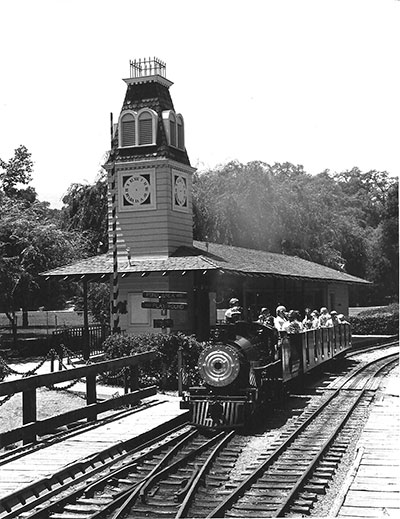
Photo Courtesy of Robert Turner.
Following Billy’s death, a group of civic-minded businesspeople decided the Wildcat Railroad needed to be saved. They formed a group which founded Billy Jones Wildcat Railroad, Inc. – a non-profit corporation dedicated to the preservation of railroad history, affordable family entertainment and the education of youth.
The entire railroad was then transferred to a parcel of land in the adjoining Oak Meadow and Vasona Parks in Los Gatos. Structures, including an engine house and train depot, along with nearly a mile of track would eventually be built. A bridge spanning Los Gatos Creek was also installed utilizing an old Southern Pacific flatcar.
Finally on July 26, 1970 the Billy Jones Wildcat Railroad began operation and continues to this day.
The Billy Jones Wildcat Railroad is known worldwide. The railroad and its famous No. 2 steam locomotive have been featured in numerous publications and television programs including On the Road with Charles Kuralt and CBS 5’s Eye on the Bay.
Most important however, is the joy that the railroad continues to give to the young and young-at-heart who enjoy the thrill of riding the rails. By 1992, the railroad was averaging well over 100,000 riders each year.
Locomotive Fleet
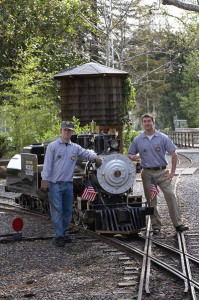
Photo courtesy of BJWRR.
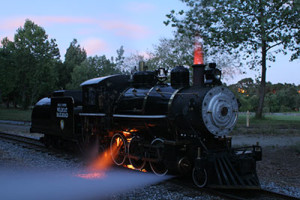
Photo by Greg Reiter.
BJWRR No. 2 was built by Johnson Machine Works in Los Angeles in 1905 exclusively for the Venice Miniature Railway in Southern California. Designed by John J. Coit, the No. 2 is a 2-6-2 “Prairie” type locomotive weighing over 9,000 pounds. It was constructed to a one-third scale running on an 18” gauge track.
The No. 2 ran at Venice Beach from 1905 until 1925 when the VMR closed. The No. 2 faded from history until it was discovered by Billy Jones in San Francisco in 1939.
Following a thorough restoration, Billy ran the locomotive on his ranch until his death in 1968. After the Wildcat Railroad was transferred to Oak Meadow and Vasona Parks, the No. 2 was again restored and continued regular operation until 1994.
From 1994 until 2005, the No. underwent a complete restoration including the replacement of its original boiler. The No. 2 finally returned to service in the summer of 2005 and the occasion not only marked the 35th anniversary of the BJWRR in Oak Meadow and Vasona Parks, but also celebrated the No. 2’s 100th birthday.
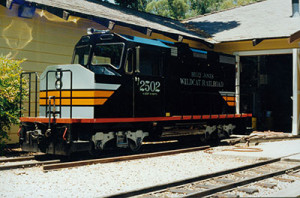
Photo by Phil Reader.
Painted in the unmistakable Southern Pacific “Black Widow” color scheme, BJWRR No. 2502 has a unique history as the first diesel locomotive on the BJWRR. Built in 1992 by Custom Locomotive Works in Chicago, the locomotive was purchased by the late Al Smith and donated to the railroad. Smith, who had incorporated Orchard Supply Hardware, was also a train buff and spent countless hours at the BJWRR and at his own ranch north of Santa Cruz.
No. 2502 received its number from one of Smith’s other locomotives which he ran on the Swanton Pacific Railroad located on his ranch. That particular diesel was numbered SPRR No. 502, hence No. 2502 became the second 502.
When the No. 2 went down for repair in 1994, No. 2502 became the mainstay of the BJWRR locomotive fleet.
In early 2002, Billy Jones Wildcat Railroad, Inc. determined that an additional diesel locomotive was necessary to assist with regular operation. Following a series of fundraising efforts, the railroad contracted with Merrick Light Railway Equipment Works in Marshall, Wisconsin to construct a diesel engine similar in style to No. 2502.
Much of the funding for the new No. 3502 was received from the late Larry Pedersen.
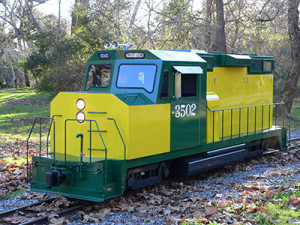
Photo courtesy of BJWRR.
In early winter of 2005, No. 3502 was delivered to the railroad and joined its sister locomotives, No. 2 and No. 2502, on the BJWRR locomotive roster. Like No. 2502, No. 3502 is similar in design and features a green and gold paint scheme.
BJWRR No. 4 has the distinction of being the first locomotive constructed entirely in the shops of the Billy Jones Wildcat Railroad. It was designed and built by Tom Waterfall, one of the railroads many volunteers.
The No. 4 was designed to serve as the railroad’s “switcher engine,” primarily responsible for moving equipment in and around the yard as well as assisting in track maintenance. While the No. 4 does not serve on passenger trains, its use and utilization continues to greatly benefit the railroad’s needs.
No. 5 is the newest and largest member of the BJWRR locomotive fleet. Like the No. 2, No. 5 is a one-third scale steam locomotive. Yet No. 5 is nearly nine feet longer and features a 4-6-2 “Pacific” style design.
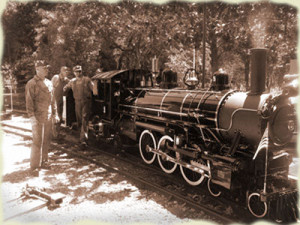
Photo by Charlie Irons.
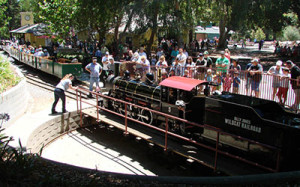
Photo by Jim Koski.
Following nearly 70 years of service on the railroad, the No. 2 was in need of additional help. The railroad deemed it necessary to add another steam locomotive to the roster and again contracted with Merrick Light Railway Equipment Works for the new locomotive’s construction.
No. 5 was eventually delivered to BJWRR in April 2013. The arrival concluded a nearly seven-year process from conception to finish and the new locomotive guaranteed BJWRR would remain a steam railroad for generations to come.
BJWRR debuted No. 5 to the public on July 28, 2013. The inaugural trip was highlighted by a double-header featuring both No. 5 and No. 2, marking the first time in the railroad’s long history that a steam double-header had been employed.
The occasion was a great cause for celebration and crowds by the thousands made their way to watch and participate in the historic event.
W.E. “Bill” Mason Carousel
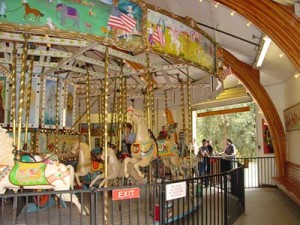
Photo by Jim Koski.
Dedicated on July 4, 1991, the W.E. “Bill” Mason Carousel represented a ten-year restoration project. It is one of the few operating historic carousels in California.
In 1980, Billy Jones Wildcat Railroad, Inc. purchased the carousel after it was discovered in a San Francisco Peninsula warehouse.
Originally manufactured by Savage in Great Britain for the 1915 Panama-Pacific Exposition, the carousel was shipped to North America around the horn of South America before the Panama Canal opened.
Savage Bros. utilized a number of unique wooden horses on the carousel, acquiring them from carvers such as G & J Lines, C.J. Spooner, Charles Dare and C.W. Parker, whose horses make up most of the carousel.
Following the exposition, the carousel became a part of a traveling circus and was then sold to a Foley & Burke Show in the 1930s.
In the 1980s, a group of volunteers set to work restoring the carousel as well as constructing a new building in Oak Meadow Park that would serve as the carousel’s permanent home. Thousands of hours of labor were required to restore and paint each of the horses as well as the remaining portions of the carousel itself.
Various paintings and decorations were also done especially for this project by local artists. In addition, a Wurlitzer-type band organ was installed inside the building to provide an antique musical experience during the ride.
These efforts combined to transform the old roundabout into a carousel that can be enjoyed by young and old alike.